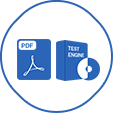Last Update 5 hours ago Total Questions : 150
The CCRN (Pediatric) - Direct Care Eligibility Pathway Exam content is now fully updated, with all current exam questions added 5 hours ago. Deciding to include CCRN-Pediatric practice exam questions in your study plan goes far beyond basic test preparation.
You'll find that our CCRN-Pediatric exam questions frequently feature detailed scenarios and practical problem-solving exercises that directly mirror industry challenges. Engaging with these CCRN-Pediatric sample sets allows you to effectively manage your time and pace yourself, giving you the ability to finish any CCRN (Pediatric) - Direct Care Eligibility Pathway Exam practice test comfortably within the allotted time.
Which of the following interventions is most effective in preventing pulmonary vasospasm in an infant with persistent pulmonary hypertension of the newborn (PPHN)?
A stat abdominal x-ray reveals free air and a large loculated fluid collection presumed to be blood. The priority of care should be:
A child with ALL presents 1 week after chemo, fatigued and hypothermic. Initial expected nursing intervention?
A 16-year-old patient is unresponsive after a motor vehicle collision. The parents speak another language. While performing the secondary survey, what should the nurse do next?
For a patient with pulmonary aspiration, PEEP is used to:
A teenage patient has an abrasion on her right forearm after a fall from a bicycle 3 days ago. The arm is cool, pale, and tight, capillary refill is greater than 5 seconds, and movement of her fingers is limited. Which of the following should a nurse anticipate as the initial treatment?
A 17-year-old on home peritoneal dialysis has new-onset fever and abdominal pain. Dialysate WBC is 185. What order should the nurse anticipate?

